Basketball is a dynamic sport rich in terms and strategies, and one of the most iconic zones on the court is the ‘paint.’ This rectangular area stretches from the baseline to the free-throw line, sandwiched between the sides of the free throw lane. Its importance is paramount both offensively and defensively, but its colloquial name might raise eyebrows for those unfamiliar with the terminology. You might also be interested in our review about the most comfortable basketball shoes, you can watch it here.
Table of Contents
What is the Paint in Basketball?
The term “paint” dates back to earlier basketball courts where this specific area was noticeably painted or marked differently, usually in a solid color, distinguishing it from the rest of the hardwood. This visual difference not only helped players position themselves but also became a staple term in basketball jargon.

Anatomy of the Basketball Paint Area
The paint basketball area, often referred to as the key, lane, or simply the paint, is central to many of the game’s strategies and plays. Its distinct shape and design serve specific purposes in regulating gameplay and offering tactical advantages.
Parts of the Paint
The main parts of the paint include the free-throw line at its top, the low post areas on both sides close to the basket, and the baseline at its bottom. The “high post” is situated just around the free-throw line area within the paint. These distinct sections facilitate various offensive and defensive plays.
Dimensions of the Paint
The standard dimensions of the paint differ slightly between leagues. In the NBA, the paint is a rectangle that is 16 feet wide. The NCAA, on the other hand, has a more narrow paint area, measuring 12 feet in width. Both extend 15 feet from the baseline, ending at the free-throw line. The differences in dimensions often necessitate variations in strategies between college and professional games.
Lines on a Court and Their Significance
Within and around the paint are several crucial lines. The free-throw line, 15 feet away from the basket, denotes where players shoot free throws. The restricted area, a semi-circle beneath the basket, determines charging violations. And the boundaries of the paint, marked by the end and side lines, play a role in enforcing the 3-second rule, ensuring players don’t remain in the paint for too long. These lines guide player positioning and influence game decisions.

Understanding the Paint Rules in Basketball
The paint, while an area of significant strategic advantage, also comes with its set of rules and limitations. Both offensive and defensive players must be cautious of their time and activities within this zone to avoid penalties. These rules, while largely standard, have nuanced differences across major basketball leagues.
The 3-second Rule Explained
The 3-second rule is fundamental to basketball and specifically targets offensive players. An offensive player cannot remain in the paint for more than three consecutive seconds while his team has possession of the ball, unless he is actively attempting to score. This rule ensures fluidity in the game, prevents crowding in the key, and challenges teams to be more dynamic in their offensive strategies.
Paint Violations and Their Consequences
Beyond the 3-second violation, other rules apply to the paint. For instance, defensive three-second violations can be called when a defender remains in the paint without actively guarding an opponent. There’s also the ‘restricted area’ rule, preventing defenders from drawing charging fouls if they’re standing within this zone. Violations typically result in technical fouls, granting the opposing team a free throw and subsequent possession of the ball.
Restrictions in the Paint: NBA vs. NCAA Basketball
While the basic principles governing the paint remain consistent, there are noticeable variations between the NBA and NCAA. In the NBA, the paint is wider, measuring 16 feet, which affects spacing and player movement. The NBA also has a defensive three-second rule, which doesn’t exist in the NCAA. This rule limits defenders from camping in the paint, promoting more man-to-man defensive schemes.
On the other hand, NCAA basketball emphasizes team-zone defenses, with the narrower 12-foot wide paint making it easier for teams to defend. Additionally, the NCAA is stricter about perimeter players entering and staying in the paint without the ball. These differences not only alter the strategies employed but also influence player development as they transition from college to professional basketball.
Strategic Importance of the Paint in a Basketball Game

The paint is more than just a marked area on the basketball court; it’s a battleground where many games are won or lost. Its strategic value is multi-faceted, influencing scoring opportunities, defensive stands, and the overall flow of the game.
Points in the Paint: Dominating the High Post
Scoring inside the paint is a critical aspect of many team’s offensive strategies. The high post, located around the free-throw line within the paint, offers a prime spot for skilled big men or agile forwards. From here, they can shoot mid-range jumpers, facilitate ball movement, or drive towards the basket. Dominating the high post often results in high-percentage shots, making it a coveted position during offensive plays.
Owning the Paint: Defensive Strategies
Defensively, controlling the paint is equally crucial. Teams that effectively “own” the paint often deter opponents from driving to the basket, forcing them to settle for less efficient outside shots. Strategies include shot-blocking, drawing charges, and using physicality to disrupt opponents. A robust defensive presence in the paint can demoralize an opposing team, making every attempted inside score a challenge.
Use the Paint for Tactical Advantage
The paint isn’t just about scoring or defending. It’s also a tool for teams to gain tactical advantages. By drawing defenders inside, space opens up for perimeter shooters. Conversely, teams can lure opponents out of the paint, creating lanes for drives and cuts. Additionally, players can exploit mismatches, using the paint to isolate smaller or less skilled defenders. Recognizing and capitalizing on these opportunities can swing the momentum of a game, showcasing the true strategic importance of the paint.
Variations Across Leagues: NBA and NCAA Basketball
While the core principles of basketball remain universally consistent, the specifications of the game, particularly concerning the paint, vary between the NBA and the NCAA. These differences not only introduce unique challenges but also influence the strategies and development paths of players across leagues.
NBA Basketball Paint Specifics
In the NBA, the paint is a broader rectangle, measuring 16 feet in width. This wider space affects the game’s dynamics by providing more room for post players to operate and guards to penetrate. The larger area also makes zone defenses less prevalent in the NBA, with an emphasis on man-to-man defensive matchups and pick-and-roll actions exploiting the spacious key.
NCAA Basketball and Its Unique Paint Characteristics
Contrasting the NBA, the NCAA features a narrower paint, spanning just 12 feet in width. This compact space often results in more crowded post plays, leading to an emphasis on team-zone defenses. The tighter confines also encourage perimeter play, with teams leveraging outside shooting to stretch defenses and create space within the paint for opportunistic inside scores.
The Free Throw Lane and Its Significance
Regardless of league, the free throw lane, which encompasses the paint, is a focal point during games. It’s from this lane that players attempt free throws after certain fouls. Additionally, its boundaries enforce various rules, such as the 3-second violations. Mastery over the free throw lane, both offensively and defensively, often correlates with a team’s success, highlighting its overarching importance in the sport of basketball.
Key Terms and Concepts Related to the Paint Area
Understanding key terms and concepts associated with the paint area is crucial for both players and fans to grasp the nuances of basketball.
What is the Restricted Area in Basketball?
The restricted area, often referred to as the “charge circle,” is a semi-circular zone located beneath the basket. Defensive players cannot draw charging fouls when inside this area. It’s designed to protect offensive players from dangerous collisions near the rim and encourages defenders to establish defensive position outside of it.
Protecting the Paint and Its Strategic Importance
Protecting the paint is a fundamental defensive strategy. By denying opponents easy access to the basket, teams can force low-percentage shots from the perimeter and limit scoring opportunities. Establishing a strong defensive presence in the paint is crucial for successful basketball, as it disrupts offensive plays and preserves a team’s defensive integrity.
Conclusion
In summary, the basketball court paint is essential for both the game’s strategy and aesthetics. It marks a key area for offensive and defensive plays, with its quality affecting visibility and durability. The paint’s color often represents the team’s identity, adding to the court’s visual appeal. Overall, it’s a crucial component that enhances the game’s playability and safety.

I’m Heorhii Rysak, a go-to sports enthusiast and blogger. My fascination with sports began in my childhood with karate, setting the foundation for my love of physical fitness. Over the years, I’ve delved into various disciplines, including martial arts and CrossFit, and developed a passion for tennis. I bring a wealth of practical experience to my blog, where I share equipment reviews, workout plans, and fitness advice. My goal is simple: to inspire and assist you in your journey toward better health and performance.